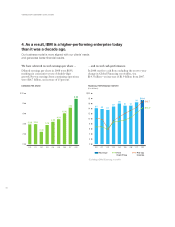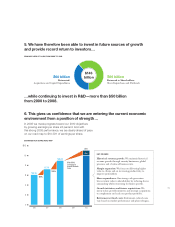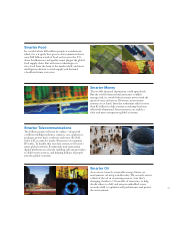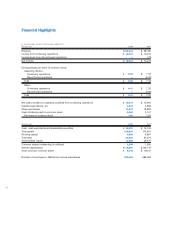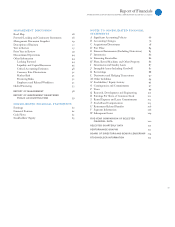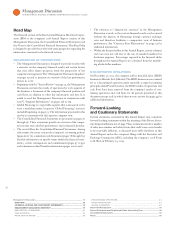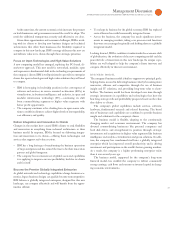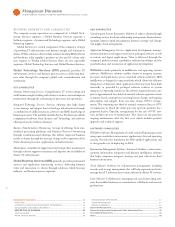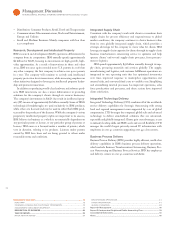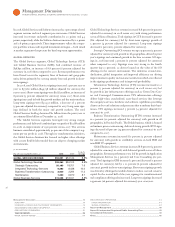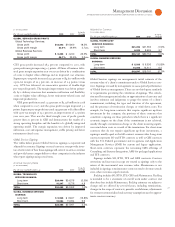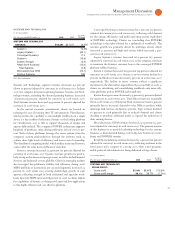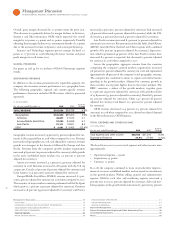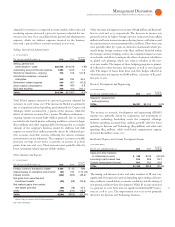IBM 2008 Annual Report Download - page 23
Download and view the complete annual report
Please find page 23 of the 2008 IBM annual report below. You can navigate through the pages in the report by either clicking on the pages listed below, or by using the keyword search tool below to find specific information within the annual report.
Management Discussion
INTERNATIONAL BUSINESS MACHINES CORPORATION and Subsidiary Companies
At the same time, the current economic crisis increases the pressure
on both businesses and governments around the world to adapt. The
needs for additional transparency, security and efficiencies are clear.
Given these opportunities and economic challenges, IBM is work-
ing with its clients to develop new business designs and technical
architectures that allow their businesses the flexibility required to
compete in this new landscape. IBM’s strategy addresses this new era
and delivers value to its clients through three strategic priorities:
Focus on Open Technologies and High-Value Solutions
A new computing model has emerged, replacing the PC-based, cli-
ent/server approach. This new model is networked, modular, open
and represents a fundamental shift in the technology requirements of
the company’s clients. IBM is well positioned to provide its enterprise
clients the open technologies and high-value solutions they will need
to compete.
• IBM is leveraging its leadership position in the convergence of
software and services, in service oriented architecture (SOA), in
virtualization, in business intelligence and analytics, in open and
modular information technology (IT) — continuing its shift
from commoditizing segments to higher value segments with
better profit opportunity.
• The company continues to be a leading force in open source solu-
tions to enable its clients to achieve higher levels of interoperability,
cost efficiency and quality.
Deliver Integration and Innovation to Clients
Changes in the market have caused IBM’s clients to seek flexibility
and innovation in everything from technical architecture to their
business model. In response, IBM is focused on delivering integra-
tion and innovation to its clients — offering them technologies and
services that support real value creation.
• IBM has a long heritage of transforming the business operations
of large enterprises and has earned the trust to be their innovation
partner and global integrator.
• The company has an extensive set of global assets and capabilities
it is applying to improve services profitability, both for its clients
and for itself.
Become the Premier Globally Integrated Enterprise
As global networks and technology capabilities change business eco-
nomics, legacy business designs can quickly become noncompetitive.
IBM believes a globally integrated enterprise, designed for this new
landscape, can compete effectively and will benefit from the oppor-
tunities offered.
• To reshape its business for the global economy, IBM has replaced
vertical hierarchies with horizontally integrated teams.
• Across the business, the company has made significant invest-
ments in emerging markets, taking core processes and functions
that were once managed regionally and shifting them to a globally
integrated model.
Looking forward, IBM is confident it understands the economic shift
of globalization, the evolution of the new computing model and the
powerful role of innovation in this new landscape. Its unique capa-
bilities are well adapted to help the company’s clients innovate and
compete effectively in this new environment.
The company’s business model is built to support two principal goals:
helping clients succeed in delivering business value by becoming more
innovative, efficient and competitive through the use of business
insight and IT solutions; and, providing long-term value to share-
holders. The business model has been developed over time through
strategic investments in capabilities and technologies that have the
best long-term growth and profitability prospects based on the value
they deliver to clients.
The company’s global capabilities include services, software,
hardware, fundamental research and related financing. The broad
mix of businesses and capabilities are combined to provide business
insight and solutions for the company’s clients.
The business model is flexible, adapting to the continuously
changing market and economic environment. The company has
divested commoditizing businesses like personal computers and
hard disk drives, and strengthened its position through strategic
investments and acquisitions in higher value segments like business
intelligence and analytics, virtualization and green solutions. In addi-
tion, the company has transformed itself into a globally integrated
enterprise which has improved overall productivity and is driving
investment and participation in the world’s fastest growing markets.
As a result, the company is a higher performing enterprise today
than it was several years ago.
The business model, supported by the company’s long-term
financial model, has enabled the company to deliver consistently
strong earnings, cash flows and returns on invested capital in chang-
ing economic environments.



